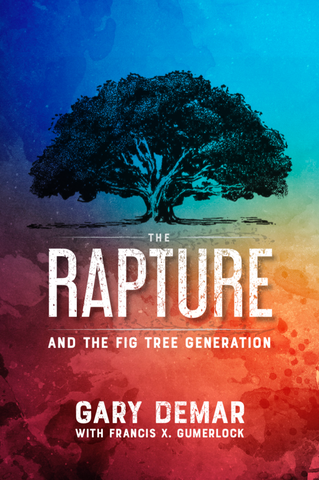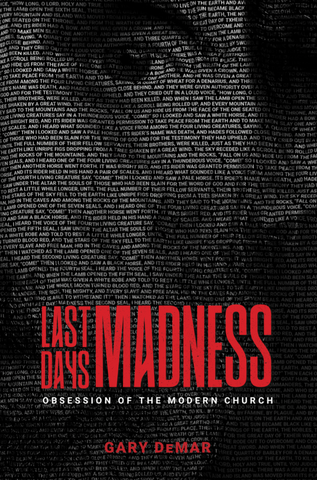If there is a single doctrine that both excites and divides Christians, it’s the ‘rapture.’ The doctrine of the ‘rapture’ deals with a future event where the church is said to be taken off the earth in one of five different times related to a seven-year period described as the Great Tribulation: before (pre-trib), at the mid-point (mid-trib), partial, just prior to God pours out His wrath (pre-wrath), or at the end of a seven-year period (post-trib) (66-79). The ‘rapture’ is said to be distinct from the Second Coming.
The doctrine has been defended in many ways over the years. For example, Tim LaHaye, co-author of the Left Behind series, wrote No Fear of the Storm: Why Christians Will Escape All the Tribulation (1992) that was later republished and given a new title, Rapture Under Attack (1998).The latest defense comes from two popular prophecy writers—Ed Hindson and Mark Hitchcock. The title of their book is Can We Still Believe in the Rapture? (2018).
Prior to collaborating with Hindson on their new book, Mark Hitchcock wrote a free eBook for Dallas Theological Seminary with the title The Truth and Timing of the Rapture that has been promoted on Facebook. What follows is a brief critique of the pre-trib rapture position. If you would like to read a more comprehensive review, see my book The Rapture and the Fig Tree Generation written with chapters by Francis X. Gumerlock.

The Rapture and the Fig Tree Generation
For decades Christians have been enticed with the belief that they would be taken to heaven before a coming tribulation period in an event called the “rapture.” Since the national reestablishment of Israel in 1948, countless books and pamphlets have been written defending the doctrine assuring readers that it could happen at any moment.
Buy NowThe five rapture positions are dependent on the belief that the 70th week (7 years) of Daniel’s 70 weeks of years (490 years) prophecy is separated from the other 69 weeks (483 years). This claim is the key to the rapture doctrine. While Hindson and Hitchcock spend 220 pages defending their version of the rapture (pre-trib), they devote one paragraph to the most necessary element that’s needed to make their view biblically sound:
Pretribulationalism teaches that the rapture of the church will occur before the commencement of the seven-year tribulation period, also known as the seventieth week of Daniel. The church will not be on earth during any part of the outpouring of God’s wrath. At some point after the rapture, the antichrist enters into a seven-year treaty or covenant with Israel (Daniel 9:27)—and that will mark the beginning of the tribulation. This position was popularized in The Scofield Reference Bible by C.I. Scofield, The Late Great Planet Earth by Hal Lindsey, and the Left Behind series by Tim LaHaye and Jerry Jenkins. (66)
If the Bible does not teach what Hindson and Hitchcock claim it teaches about the seventieth week of Daniel, then the answer to their question—Can We Still Believe in the Rapture?—is no.
I’m surprised that an entire chapter is not devoted to the key factor that makes any of the rapture positions work. If the 70th week (7 years) of Daniel follows the other 69 weeks (483) without a gap in time that has now stretched to nearly 2000 years, then there is no reason to believe their understanding of the ‘rapture’ is biblical.
They also must demonstrate from Scripture that “the antichrist enters into a seven-year treaty or covenant with Israel” and so much more. You don’t need to be a biblical scholar to see that there is no mention of a gap in the prophecy (Dan. 9:24-27) or an antichrist who makes a covenant with the Jews. Read the passage for yourself. See my book Last Days Madness.

Last Days Madness
In this authoritative book, Gary DeMar clears the haze of "end-times" fever, shedding light on the most difficult and studied prophetic passages in the Bible, including Daniel 7:13-14; 9:24-27; Matt. 16:27-28; 24-25; Thess. 2; 2 Peter 3:3-13, and clearly explaining a host of other controversial topics.
Buy NowDaniel 9 begins with Daniel reading the prophet Jeremiah where he is reminded that the number of years of the captivity was “seventy years” (Dan. 9:2; Jer. 25:11, 12; 2 Chron. 36:21; Ezra 1:1; 29:10; Zech. 7:5). Was there a gap in time, a postponement of the 70th year of captivity? There wasn’t. The seventy weeks of years is patterned after the 70 years of captivity. Neither postulates a gap.
Jesus’ ministry begins at the beginning of the 70th week (7 years) that follows directly after the 69th week (483 years). Jesus is “cut off” in the middle of the week by crucifixion but not before He (not the Antichrist) “makes a covenant” with “the many” (Dan. 9:27; Matt. 26:26-28). The following 3.5 years of the 70th week when the gospel is embraced by Jews “from every nation under heaven” (Acts 2:5-11; also see 2:14, 22, 39, 47; 4:4; 5:11, 14). The 70th week ends sometime between the martyrdom of Stephen and when Peter receives instructions by God to take the gospel to the Gentiles (nations) who are grafted into an already growing body of Jewish believers. There is no mention of a gap in time or a need for one.
There’s one other item that the authors fail to mention. They quote Hank Hanegraaff (12) , who is critical of their view, that during the tribulation period “twenty-first century Jews will soon die in an Armageddon that will make the Nazi Holocaust pale in comparison.”[1]
What is Hanegraaff referring to? While the church is said to be taken to heaven in a rapture to avoid the tribulation (pre-trib), the Jews will suffer another holocaust. Mark Hitchcock contends in his book, Could the Rapture Happen Today? (94) that the prophecy found in Zechariah 13:8-9 states that “two parts” of the Jews living in the land of Israel during the post-rapture tribulation period “will be cut off and perish.”
This interpretation is not unique to Hitchcock. Fellow pre-tribulationalist Hal Lindsey describes the judgment against Israel in AD 70 as a “picnic” compared to a super-holocaust that will lead to the slaughter of two-thirds of the Jews living in Israel during the Great Tribulation.[2]
In Jack Van Impe’s Israel’s Final Holocaust readers are told that when the prophecy clock starts ticking again after the “rapture,” it “will be traumatic days for Israel. Just when peace seems to have come, it will be taken from her and she will be plunged into another bloody persecution, … a devastating explosion of persecution and misery for Israel….”[3]
Thomas Ice, a frequent co-author with Hitchcock, writes “that before Israel enters into her time of national blessing she must first pass through the fire of the tribulation (Deut. 4:30; Jer. 30:5-9; Dan. 12:1; Zeph. 1:14-18). Even though the horrors of the Holocaust under Hitler were of an unimaginable magnitude, the Bible teaches that a time of even greater trial awaits Israel during the tribulation. Anti-Semitism will reach new heights, this time global in scope, in which two-thirds of world Jewry will be killed (Zech. 13:7-9; Rev. 12).”[4] The Great Tribulation that Jesus described in the Olivet Discourse and other places in the Synoptic Gospels (Luke 17:22-37; 19:41-44; 21:5-36) served as a warning to the first-century generation. Notice that Jesus gave ample warning to that generation to flee (Mt. 24:15-20). No one is warning Jews in Israel to flee. In fact, dispensationalists who claim to love the Jews are encouraging Jews to return to their homeland where, if the dispensationalists are right, two-thirds of them will be slaughtered.
Charles Ryrie writes in his book The Best is Yet to Come that during this post-rapture period Israel will undergo “the worst bloodbath in Jewish history.”[5] Please explain how such a view fits with the dispensational view that Jesus must fulfill His promises to Israel? By allowing the antichrist to slaughter millions of Jews?
John Walvoord follows a similar line of argument: “Israel is destined to have a particular time of suffering which will eclipse anything that it has known in the past…. [T]he people of Israel … are placing themselves within the vortex of this future whirlwind which will destroy the majority of those living in the land of Palestine.”[6]
Arnold Fruchtenbaum states that during the Great Tribulation “Israel will suffer tremendous persecution (Matthew 24:15-28; Revelation 12:1-17). As a result of this persecution of the Jewish people, two-thirds are going to be killed.”[7]
The authors of Are You Rapture Ready? continue with the Jewish holocaust theme describing it as “Holocaust II” when “66 percent of Israel is wiped out.”[8]
It’s the claim of pretribulationalists that during the 2000-year postponement, God has been dealing with the ‘church.’ After the ‘rapture’ of the church, God will once again work with His chosen people, Israel. Finally, after nearly 2000 years of waiting, God is going to allow the antichrist to slaughter His chosen people so that “66 percent of Israel is wiped out.” This makes absolutely no sense.
The prophecy found in Zechariah 13:8-9 refers to what Jesus describes in the Olivet Discourse (Matt. 24). The disciples ask about the destruction of the temple. Jesus tells them, “Do you not see all these things? Truly I say to you, not one stone here will be left upon another, which will not be torn down” (24:2). This event took place before that generation passed away (24:34). Jesus gave the opportunity to avoid the judgment by leaving Jerusalem and heading to the mountains outside of Judea (24:16).
The Great Tribulation described by Jesus was local. They would “see the abomination of desolation.” The people were living in homes where the roofs were used as a patio. The coming judgment could be escaped on foot. The Sabbath was still in operation (24:15-22).
Much more could be said in critique of Can We Still Believe in the Rapture? If you are interested in a more detailed study, see the book The Rapture and the Fig Tree Generation.
[1]The Apocalypse Code (Nashville: Thomas Nelson, 2007), xxi.
[2]Hal Lindsey, The Road to Holocaust (New York: Bantam Books, 1989), 220.
[3]Jack Van Impe with Roger F. Campbell, Israel’s Final Holocaust (Nashville: Thomas Nelson, 1979), 37.
[4]Thomas Ice, “What do you do with a future National Israel in the Bible?” Emphasis added.
[5]Charles C. Ryrie, The Best is Yet to Come (Chicago, IL: Moody Press, 1981), 86.
[6]John F. Walvoord, Israel in Prophecy (Grand Rapids, MI: Zondervan, 1962), 107, 113. Emphasis added.
[7]Arnold G. Fruchtenbaum, “The Little Apocalypse of Zechariah,” The End Times Controversy: The Second Coming Under Attack, eds. Tim LaHaye and Thomas Ice (Eugene, OR: Harvest House, 2003), 262.
[8]Strandberg and James, Are You Rapture Ready?, 77.

